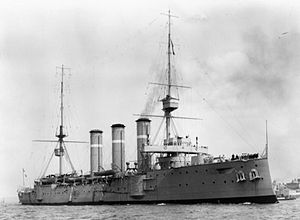 Cumberland at anchor
| |
| History | |
|---|---|
| Name | Cumberland |
| Namesake | Cumberland |
| Builder | London and Glasgow Shipbuilding, Govan |
| Laid down | 19 February 1901 |
| Launched | 16 December 1902 |
| Completed | 1 December 1904 |
| Decommissioned | Paid off, April 1920 |
| Fate | Sold for scrap, 9 May 1921 |
| General characteristics | |
| Class and type | Monmouth-class armoured cruiser |
| Displacement | 9,800 long tons (10,000 t) (normal) |
| Length | 463 ft 6 in (141.3 m) (o/a) |
| Beam | 66 ft (20.1 m) |
| Draught | 25 ft (7.6 m) |
| Installed power |
|
| Propulsion | 2 × shafts; 2 × triple-expansion steam engines |
| Speed | 23 knots (43 km/h; 26 mph) |
| Complement | 678 |
| Armament |
|
| Armour |
|
HMS Cumberland was one of 10 Monmouth-class armoured cruisers built for the Royal Navy in the first decade of the 20th century. She was assigned to the 2nd Cruiser Squadron of the Channel Fleet upon completion in 1903. After a refit in 1907–1908 she became a training ship in the Home Fleet. She was sent to West Africa after the beginning of World War I in August 1914 and captured 10 German merchant ships in September. Cumberland spent the rest of the war on convoy escort duties and patrolling for German commerce raiders. She was sold for scrap in 1921 and broken up two years later.